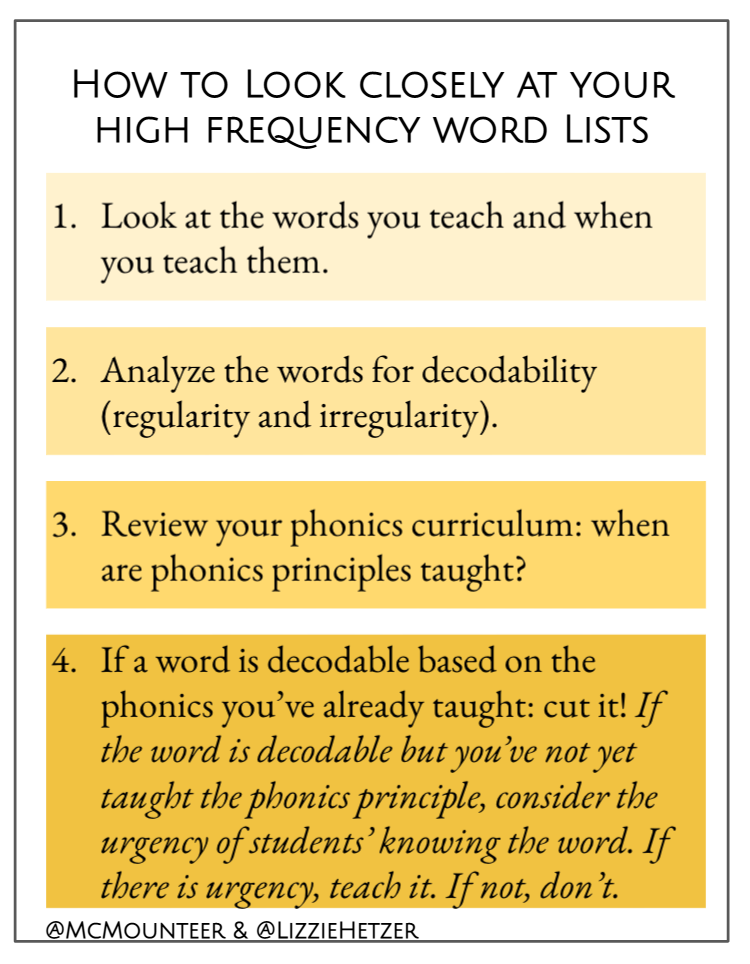Dear Reader,
Before reading this post, check out last week’s post on important shifts regarding how to teach high frequency words if you haven’t already. This week, we’ll build on that post by offering our latest ideas on how to choose high frequency words to teach.
To start us off, let’s take a look at this great visual from Shifting the Balance by Jan Burkins and Kari Yates (p.103) (link). We like the criteria and questions the authors offer to help guide the choices you might make when choosing which words to teach.
After looking at this table and thinking of the research we referenced last week, we wonder if there are words that we could eliminate from our teaching. We’d argue that words that are regular phonetically, aligned to phonics instruction, and not urgent might not need to be included in the lists of words for teaching.
For example, in the beginning of the year in first grade, many curricula and lists include words like on, an, at, can, him, let, had and got. These are all phonetically regular (each grapheme represents the most commonly attributed sound), and since most phonics instruction programs teach the alphabet, CVC and short vowel words in kindergarten the phonics knowledge needed to decode those words has been taught. That means that students should be able to decode these words when they encounter them in print without having to have studied the word in isolation. Furthermore, since they will be encountering and decoding these words in print often (since they are high frequency) they will be more likely to orthographically map these words, making it less urgent for us to teach these words specifically.
Essentially the question is: do all of the words on the lists of high frequency words (or snap words) need to be taught? Teaching fewer words frees up time for review of other words or focus on additional phonics instruction/review. (And certainly, regular high frequency words could be reviewed!)
We’ve come up with some steps for looking at the words you currently teach to decide which words you might cut.
Marie looked at the first 100 Words from the Fry List (here) and coded it:
1 check mark next to any words that were decodable if children know letter sounds and how to read CVC words.
2 check marks next to CCVC words with the th digraph.
3 checkmarks next to CCVC words with the wh digraph.
If we assume that students know the alphabet, CVC words, and the th and wh blend, you could remove 25 words off the list of 100 (for teaching purposes). Additionally, depending on when you teach the CVCe pattern, you could remove 3 more words from the list.
Then (for the fun of it!) Marie went on to circle words that could be taught together because of similar phonics patterns/sounds. It was cool to see how many words on this list have the s making the /z/ sound. Here’s the image:
We invite you to try this with the list provided by your curriculum.
The big idea here is that by first grade (and perhaps at the end of kindergarten) you may want to make adjustments to what you teach based on your students’ phonics knowledge. For more information on Fry and Dolch and where these lists come from look at this article. For more ideas on which words you might teach and when, check this out this article from Reading Rockets. There are also some great ideas on which words and how to teach them in these books we’ve referenced many times:
Letter Lessons and First Words by Heidi Anne Mesmer and
How To Plan Differentiated Reading Instruction by Sharon Walpole and Michael C. McKenna. Walpole and McKenna offer some of their resources free here.
See you next week!
Lizzie and Marie





